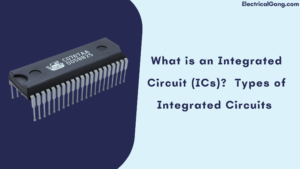
In our daily life, we use various electronic items. Just like we use different things like mobiles, televisions, and laptop computers. In which somehow some complex or straightforward circuit is used in all electronic or electrical devices.
Electronic circuits are felt by connecting wires to each other using multiple electrical and electronic components or by conducting wires for the flow of electric current through various components of the circuit such as resistors, capacitors, diodes, inductors, transistors, etc.
Circuits are classified into different types based on various criteria. Such as series circuits and parallel circuits based on connection, integrated circuits, and isolated circuits based on the size of the circuit and the manufacturing process. Analog circuits and digital circuits depend on the signal used in the circuit.
In today’s article, what is an integrated circuit? And Types of Integrated Circuits. Today we will discuss an overview of integrated circuits and their applications.
What is an Integrated Circuit (ICs)?

Integrated circuits are also known by the acronym IC. This circuit is a microchip or chip is a microscopic electronic circuit array that is constructed on a semiconductor material wafer using various electronic and electrical components like resistors, capacitors, transistor MOSFET, etc, which can perform the same operation on a large electronic component made up of different electronic components.
All these arrays of components, the microscopic circuit, and the semiconductor wafer material base are integrated together to form a single chip. That is why it is known as an integrated circuit or integrated chip or microchip.
Electronic circuits are developed using individual or different electronic components of different sizes, as the cost and size of these different circuits increase with the number of components used in the circuit. Integrated circuit technology was developed to overcome this negative aspect. The integrated circuit was first developed by Jack Kilby of Texas Instruments in 1950, and then Robert Noyce of Fairchild Semiconductor solved some of the practical problems of this integrated circuit.
Suggested Read: Electrical Substation Components and Their Workings
History of Integrated Circuits:
The history of integrated circuits began with the solid-state device. The first vacuum tube was discovered by John Ambrose (J.A) Fleming in 1897, also known as the vacuum diode. As for the motor, he also invented the rule of the left hand. Then in 1906, a new vacuum was discovered. Which was named triode and is used for expansion.
The transistor was then invented in Bell Labs in 1947 to partially replace the vacuum tube because of the small components of the transistor that use a small amount of power to work. Different circuits were arranged on printed circuit boards by using different components separately as well as by hand control called unconnected circuits. This IC uses a lot of power and space and its output is not very smooth.
The integrated circuit was developed in 1959. Where many electronic and electrical components were made on a single silicon wafer. Integrated circuits use less power to operate as well as provide smoother output. The increase of the transistor on the integrated circuit can also be increased.
Integrated Circuit Evolution from Different Technologies:
ICs can be classified based on the size of the chip and the integration scale. Here the integration scale specifies the number of electronic components placed in a typical integrated circuit.
From 1961 to 1965, small-scale integration technology was used to make 10 to 100 transistors on a single chip to make flip-flops and logic gates.
From 1966 to 1970, medium-scale integration (MSI) technology was used to make 100 to 1000 transistors on a single chip for the manufacture of multiplexers, decoders, and counters.
From 1971 to 1979, large-scale integration technology was used to make 1000 to 20000 transistors on a single chip for the construction of RAM, Microprocessor, and ROM.
From 1980 to 1984, very-large-scale integration (VLSI) technology was used to build RISC microprocessors, DSPs, and mi16-bit and 32-bit microprocessors to create 20,000 to 50,000 transistors on a single chip.
From 1985 until now, Ultra Large Scale Integration (ULSI) technology has been used to build 6400-bit microprocessors to build 50000 billion transistors on a single chip.
Limitations of Different Types of Integrated Circuits:
Different types of ICs have many limitations, some of which are as follows:
- It has a limited power rating.
- It operates on low voltages.
- Makes a little too much noise while performing this operation.
- A high rating of PNP is unlikely
- It is difficult to build an IC with low noise.
- Its components are voltage-dependent like resistors and capacitors.
- It is fragile.
- The temperature coefficient is difficult to achieve.
- Assembly of high-grade PNP cannot be achieved.
- The various components in the IC cannot be changed or removed. That way if a component goes bad in the IC, it will have to replace the entire IC with a new one.
- Power rating in IC is limited as it is not possible to produce IC with a power rating above 10 watts.
Suggested Read: What are Semiconductor Devices? | Semiconductor Device Materials
Different Types of Integrated Circuits:
There are many types of ICs available in the market but ICs are classified according to different criteria. The classification of how many types of ICs there are in the system can be understood by the figure below.

ICs are classified as Analog Integrated Circuits, Digital Integrated Circuits, and Mixed Integrated Circuits based on the desired application.
| Sr. No. | Types of Integrated Circuits |
| #1 | Digital Integrated Circuits |
| #2 | Analog Integrated Circuits |
| #3 | Mixed Integrated Circuits |
| #4 | Logic Circuits |
| #5 | Comparators |
| #6 | Switching ICs |
| #7 | Audio Amplifiers |
| #8 | CMOS Integrated Circuit |
| #9 | Voltage Regulator ICs |
| #10 | Operational Amplifiers |
| #11 | Timer ICs |
#1. Digital Integrated Circuits:
An integrated circuit that operates only at certain defined levels instead of managing the overall level of the signal vibration area is known as a digital IC. This IC can be designed using digital logic gates, multiplexers, flip-flops, and other electronic components of the circuit. These logic doors work with binary input data or digital input data. Such as 0 (low or false or logic 0) and 1 (high or true or logic 1).
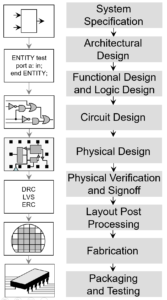
Image Credit: www.upload.wikimedia.org
The figure above shows the steps involved in the design of a typical digital integrated circuit. Such digital ICs are frequently used in computers, microprocessors, digital signal processors, computer networks, and frequency counters. There are different types of digital ICs such as logic ICs, programmable ICs, memory chips, power management ICs, and interface ICs.
#2. Analog Integrated Circuits:
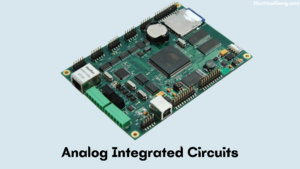
An integrated circuit that operates in a series of continuous signals is known as an analog IC. These circuits are divided into linear integrated circuits and radio frequency integrated circuits. In fact, the relationship between the current and the voltage can in some cases be nonlinear in a long range of continuous analog signals.
The most widely used analog IC is an operational amplifier or op-amp. Which is similar to a differential amplifier but has a very high voltage gain. It has a much smaller number of transistors compared to digital ic and uses computerized simulation tools to develop analog application-specific integrated circuits (analog ASICs).
Linear Integrated Circuits:
n analog integrated circuits if a linear relationship exists between its voltage as well as current it is known as linear IC. The best example of this linear IC is 741 IC, 8-pin DIP (dual in-line package) op-amp,
Radio Frequency Integrated Circuits
In an analog integrated circuit if a non-linear relationship exists between its voltage and current it is known as radiofrequency ICs. This type of IC is also known as a radio frequency integrated circuit.
Suggested Read: What is a Signal Isolator? | Working Principle of Signal Isolator
#3. Mixed Integrated Circuits:

Image Credit: www.darpa.mil
Integrated circuits obtained by a combination of digital and analog ICs on a single chip are known as mixed ICs. This IC works as an analog-to-digital converter and a digital-to-analog converter and a clock IC.
An example of a mixed integrated circuit as shown in the figure above is a photo of an 8 to 18 GHz self-healing radar receiver. This is the result of advances in mixed-signal systems-on-a-chip integration technology, enabling the integration of digital, multiple, and RF functions on a single chip.
#4. Logic Circuits:

This IC is designed to use logic gates that work with binary inputs and outputs (0 or 1). This is especially used by decision-makers. Provides output based on logic gates logic or truth table, a circuit connected inside all logic gates connected to IC. As such this output is used for a specific purpose function. A few logic ICs are shown below.
Suggested Read: What is Transducer? | Types of Transducer | Application of Transducer
#5. Comparators:
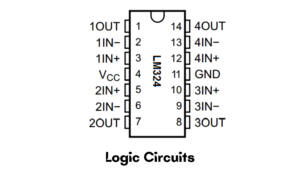
Comparable ICs are used to compare inputs. Outputs are then generated based on comparisons of ICs.
#6. Switching ICs:
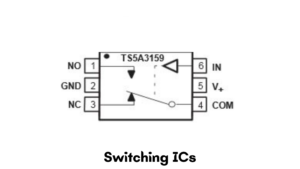
The switch or switching is constructed using an IC transistor and is used to perform the switching operation. The following figure is an example showing the SPDT IC switch.
#7. Audio Amplifiers:
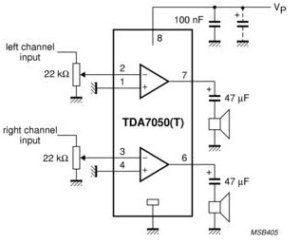
Many types of ICs are used in audio amplifiers. This is also one of the many types of IC. Which is used for the expansion of audio. This IC is commonly used in audio speakers, television circuits, etc. The low-voltage audio amplifier IC is shown below.
Suggested Read: Circuit Breaker Keeps Tripping Without Load | Quick Fix
#8. CMOS Integrated Circuit:
CMOS integrated circuits are most commonly used in different applications compared to FETs due to their capabilities such as low threshold voltage, and low power consumption. CMOS IC consists of P-MOS and N-MOS devices that are built together on the same chip. The structure of this IC is a polysilicon gate which helps to reduce the threshold voltage of the device, thus allowing processing at low-voltage levels.
#9. Voltage Regulator ICs:
This type of integrated circuit provides a stable DC output despite changes in DC input. The most commonly used types of regulators are LM309, uA723, LM105, and 78XX ICs.
#10. Operational Amplifiers:

Operational amplifiers often use IC as an audio amplifier, which is used for audio amplification. This op-amp is used for the purpose of amplification, and this IC transistor acts in the same way as the amplifier circuit. The pin configuration of the 741 op-amp IC is shown in the figure below.
#11. Timer ICs:
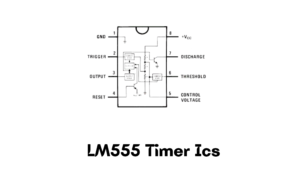
Timer IC is a special-purpose integrated circuit that is used to keep track of time in a purposeful application for the purpose of calculation. The block diagram of the LM555 timer IC is shown in the circuit below. Depending on the number of components used (depending on the number of transistors commonly used), it is as follows.
Small-scale integration involves only a few transistors. This ICA played a crucial role in early aerospace projects. Medium-scale integration involves several hundred transistors on an IC chip developed in the 1960s and achieves better economy and advantages compared to SSI IC.
Large-scale integration involves thousands of transistors on a chip. Which is with medium-scale integration ICs with almost the same economy. The first microprocessor, calculator chips, and 1Kbit RAMs, developed in the 1970s, included less than 4,000 transistors.
Large-scale integration involves hundreds to billions of transistors. (Development period: 1980 to 2009).
Ultra-large scale integration involves more than one million transistors. And later developed Wafer-Scale Integration (WSI), Chip-on-System (SoC), and Three-Dimensional Integrated Circuits (3D-IC).
All this can be considered as the generation of integrated technology. ICs are also classified on the basis of packing technology and fabrication technology. There are many types of IC, in which IC will act as a timer, counter, register, amplifier, logic gate, oscillator, adder, microprocessor, etc.
Suggested Read: What Is a Coupling Capacitor | Construction of Coupling Capacitor
Types of Integrated Circuits based on Classes:
Integrated circuits are available in the market in three categories depending on the technology used in making them.
- Thin and thick film ICs.
- Monolithic ICs.
- Hybrid or multichip ICs.
- Dual-In-Line Package (Dip) ICs.
#1. Thin & Thick ICs:
This type of IC uses passive components such as capacitors and resistors although the transistor and diode are connected as separate components for designing. These ICs are simply a combination of an integrated circuit as well as a separate component and these ICs have relevant characteristics and appearance apart from the way of film testimony.
These ICs are designed by running films that deposit materials on the surface of glass or on a ceramic stand. Changing the thickness of the films on the material will have different resistivity and a passive electronic component can be produced.
In this type of integrated circuit, the silk print method is used to create the required model on the ceramic substrate. Sometimes, these types of ICs are called printed thin-film ICs.
#2. Monolithic ICs:
In this type of IC, the silicon chip is formed by the interconnection of active and passive and separate components. It is derived from the Greek word mono is nothing but singular while lithos means stone as its name implies. This IC is currently used for its low cost and reliability.
These ICs, which are commercially constructed, are used as voltage regulators, amplifiers, computer circuits, and AM receivers. Although these IC components have poor insulation, their power rating is also low.
#3.Hybrid or Multichip ICs:
As its name suggests, multi means above an individual chip that is connected to each other. These ICs include active components such as diodes or diffused transistors. While inactive components are capacitors or resistors scattered on a chip.
These components can be combined by the method of metalized prototypes. This type of integrated circuit is widely used for the application of high-power amplifiers from 5W to 50W. Compared to monolithic integrated circuits, the performance of hybrid IC is good.
#4. Dual-In-Line Package (Dip) ICs.
In terms of DIP (Dual In-Line Package) or DIPP (Dual In-Line Pin Package) electronics or microelectronics, there are two parallel boards and two parallel rows with electrical connecting pins.
Types of IC Packages:
ICs are divided into two types based on packages as follows:
- Through-Hole Mount.
- Surface Mount Packaging.
#1. Through-Hole Mount:
This can be designed where the lead pin is fixed by one face of the board and on the other side smokes. Compared to other types, these packages are larger in size. This is mainly used in electronic devices to balance the space of the board as well as the cost limit.
The best example of this package is the dual inline package as it is the most used. This package is available in two types of ceramic and plastic. In ATmega328, the 28-pins are located parallel to each other by extending vertically and laying on a rectangular-shaped board of black plastic.
The space between the pins is kept at 0.1 inches and also varies in size due to the difference in package number. These pins can be arranged in different packages in such a way that they can be controlled in the middle of the breadboard so that short circuits do not occur.
The various through-hole mount IC packages are PDIP, DIP, ZIP, PENTAWATT, T7-TO220, TO2205, TO99, TO220, TO92, TO18, and TO03.
#2. Surface Mount Packaging:
This type of packaging typically follows the mounting technique or the components are located directly on the PCB. Yet the method of its creation helps to make things faster. It also corrects the possibility of error due to the small component and they are arranged very close to each other.
Plastic or ceramic molding is used in this type of packaging system. Different types of surface-mounted packaging that use plastic mold are small profile L-led packages and BGA (ball grid array).
The various surface mount IC packages are SOT23, SOT223, TO263, DDPAK, SOP, TSOP, TO252, TQFP, QFN, and BGA.
Advantages of Integrated Circuits:
The advantages of an integrated circuit are as follows:
Power Consumption is Low:
This circuit uses less power to work evenly due to its small size and construction.
Size is compact:
A smaller circuit can be obtained using IC for a given efficiency compared to a separate circuit.
Less Cost:
Compared to discrete circuits, integrated circuits have lower costs due to their fabrication technology as well as less material.
Less Weight:
Circuits that use integrated circuits weigh less than separate circuits.
Operating Speed is Improved:
Integrated circuits operate faster due to their switching speed as well as low power consumption.
Disadvantages of Integrated Circuits:
The various disadvantages of integrated circuits are as follows:
- It cannot dissipate heat due to its small size and IC can be damaged due to overflow of flow.
- Transformers, as well as inductors, cannot be included in this circuit.
- It handles a limited range of power.
- The low-temperature coefficient cannot be achieved.
- The power dissipation range is up to 10 watts.
- Operation of high voltage and low noise cannot be obtained.
Most Commonly Asked Questions:

How many types of integrated circuits are there?
There are mainly two types of integration which are as follows:
- Digital ICs.
- Analog ICs.
What are the different types of ICs?
The classification of different types of ICs based on chip size is as follows:
- SSI: Small-scale integration. 3 – 30 gates per chip.
- MSI: Medium Scale Integration. 30 – 300 gates per chip.
- LSI: Large-scale consolidation. 300 – 3,000 gates per chip.
- VLSI: Very-large-scale integration. More than 3,000 gates per chip.
What are the four classifications of ICs?
There are different types of digital ICs such as logic ICs, programmable ICs, memory chips, power management ICs, and interface ICs.
What are the different types of IC packaging?
- DIP (Double In-line Package).
- SOP/SOIC/SO (Small Outline Package).
- QFP (Quad Flat Package).
- QFN/LCC (Quad Flat Non-leaded Package).
- BGA (Ball Grid Array Package).
- CSP (Chip Scale Package).
Like this post? Share it with your friends!
Suggested Read –